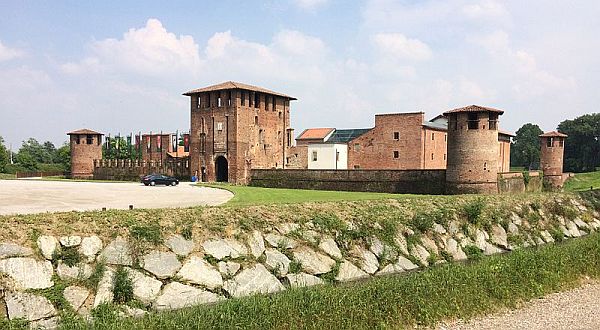Description

The medieval castle rised up beside the river
The Visconti castle of S. Giorgio rises on an island
created by the fork of Olona river which, downstream,
creates a floodplain area for the floods of the river.
Since its origin, between the 9th and 10th centuries, it
has gone through alternating events, passing from convent
to fortress, from noble villa to farm and finally to
museum, in close connection with the surrounding
agricultural areas and the system of mills of Olona
river.
The
Visconti's Saint George Castle springs up on an island
originated from a fork the Olona river that gathers when
it reaches the valley creating a marsh for the overflows.
The area was originallyy surrounded by cultuvated fields
and was reachable from a 500-600's bridge formed by a
still existing rock arch.
Regular Augustinian Convent with a little church dedicated
to Saint George and cultivable lands, in XIII century,
period in which the agricultural activity was thriving
thanks to the mills, the building was turned into a
Castrum by Ottone Visconti, archbishop of Milan, since,
between Milan and Verbania, at the limits of Seprio
Earldom, thanks to its natural defensive position, played
the role of shelter for the military expeditions.
Originally formed by a quadrangular tower against which
other constructions leant on, followed the destiny of the
Visconti's dinasty and of the long disputes with Torrians,
until in 1437 Filippo Maria Visconti donated it to Oldrado
II Lampugnani, his right-hand, who expanded it in 1445
making it a noble fortified construction with a
quadrilateral structure inspired by the castle of Milan,
by building castellated ramparts, the great tower at the
entrance (with a marble gravestone including coats of arms
and capital letters), cylindrical towers at the side,
drawbridge and defensive floodable moat.
Oldrado III, between 1523 and 1528, enlarged the complex
further, had it frescoed and rebuilt the parts that had
been damaged by the fights between the imperial troops and
the French ones for the dominion over Milan's dukedom.
In 1792, after some quarrels about the property right,
the complex was purchased, toghether with the annexed
holding, by the family of the marquesses Cornaggia Medici,
that earlier turned it into a stay residence, by having
the towers frescoed, readjusting the church - used as
family tomb and private oratory - and creating a terrace
on the southern side towards the Olona, later converted it
into a farm, by building, with the material subtracted
from the crenellations and destroyed towers, stables for
bovines and horses and barns in the courtyard, and
dividing the internal spaces into apartments for the
lessees and the employees who managed the cattle and the
surrounding lands (fam. Villa).
In 1973, after years of neglect that determined several
losses, the castle and the surrounding farming areas
became municipal properties, who began the refurbishment
of the building turning it into a space for the
exhibitions, at the same time of the foundation, in the
bordering area, of the Castle Park.
The recent works, concerning the banks and the
neighbourhoods of the building, gave backthe whole area to
the public domain, improving the use also from the
landscape and environmental point of view.
Deepening
Video |
Audio |
E-Book |
Photo |
Other Links |


